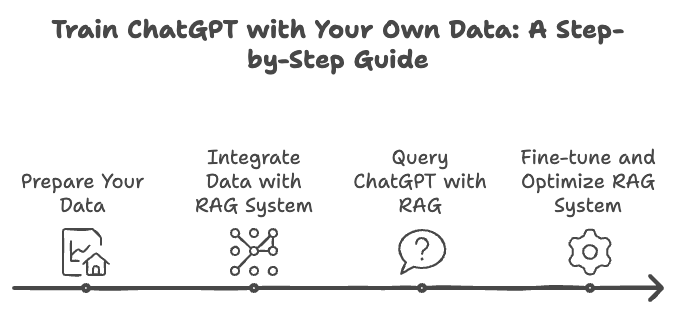Imagine having a conversation with ChatGPT, the AI language model that’s been taking the world by storm. You’re amazed by its ability to understand and respond to your questions, but you can’t help but wonder—
What if ChatGPT could tap into your own treasure trove of data? What if it could provide answers and insights tailored specifically to your needs? What if I can train ChatGPT with MY DATA!
Well, buckle up, because we’re about to embark on a journey to make that happen!
Understanding Retrieval-Augmented Generation (RAG)
First things first, let’s talk about Retrieval-Augmented Generation, or RAG for short. RAG is like giving ChatGPT a secret weapon—it allows the AI to retrieve relevant information from a custom dataset and use it to generate more accurate and contextual responses. Think of it as ChatGPT’s personal library, filled with knowledge that’s specific to your domain or industry.
So, why should you care about RAG?
By integrating your own data with ChatGPT, you can unlock a whole new level of possibilities. Whether you’re a business looking to provide personalized customer support, a researcher aiming to explore domain-specific insights, or an enthusiast eager to build your own AI assistant, RAG can help you achieve your goals.
Preparing Your Data for RAG
Now, before we dive into the technical nitty-gritty, let’s talk about your data. The quality and structure of your data will play a crucial role in the success of your RAG system. You’ll want to ensure that your data is organized, clean, and relevant to your intended use case.
When it comes to structuring your data for RAG, you have a few options. You can choose to store your data in a format like JSON, CSV, or even plain text files. The key is to break your data down into smaller chunks or passages that can be easily retrieved based on relevant queries.
But wait, there’s more! You’ll also need to preprocess and clean your data to ensure that it’s in tip-top shape for retrieval. This might involve removing any irrelevant or duplicated information, standardizing formats, and performing text normalization techniques.
Integrating Your Data with a RAG System
Now that your data is prepped and ready to go, it’s time to choose your RAG system. There are a few popular options out there, each with its own strengths and quirks.
Take ElasticSearch, for example. This powerful search engine is like a trusty sidekick for your RAG system, allowing you to index and search through your data with lightning speed. Or, if you’re feeling adventurous, you might want to check out FAISS, Facebook’s library for efficient similarity search and clustering of dense vectors.
But wait, there’s a new kid on the block! Have you heard of Pinecone? This vector database is specifically designed for AI applications, making it a breeze to integrate with your RAG system.
No matter which RAG system you choose, the process of integration typically involves indexing your data, configuring retrieval settings, and defining the queries that will trigger the retrieval of relevant information.
Querying ChatGPT with RAG
Alright, now comes the moment of truth—putting your RAG system to the test! When you query ChatGPT with a question or prompt, the RAG system springs into action, scouring your custom data for relevant information.
But hold on, crafting effective queries is an art form in itself. You’ll want to strike a balance between specificity and flexibility, ensuring that your queries capture the essence of the information you’re seeking while allowing room for contextual interpretation.
Once the RAG system retrieves the relevant passages from your data, ChatGPT works its magic, analyzing the retrieved information and generating a response that seamlessly incorporates the custom knowledge. It’s like having a superhero AI assistant that’s tailored to your specific needs!
Fine-tuning and Optimizing Your RAG System
But the journey doesn’t end there. As with any AI system, there’s always room for improvement. Fine-tuning and optimizing your RAG setup is an ongoing process that requires a keen eye and a willingness to experiment.
You might find yourself tweaking retrieval parameters, adjusting similarity thresholds, or even exploring advanced techniques like query expansion or re-ranking. The goal is to strike a balance between retrieval accuracy and efficiency, ensuring that your RAG system delivers the most relevant and useful information in a timely manner.
And don’t forget about the importance of keeping your custom data up to date! As your knowledge evolves and new information emerges, you’ll want to regularly update and maintain your dataset to ensure that ChatGPT has access to the latest and greatest insights.

🚀 Introducing ChatCube: Your No-Code Solution for Custom ChatGPT-like Chatbots
Now, I know what you’re thinking:
“This all sounds amazing, but I’m not a tech wizard! How can I possibly create my own ChatGPT-like chatbot without spending months learning how to code?”
Fear not, my friend, because ChatCube is here to save the day! 🦸♀️
ChatCube is like the fairy godmother of chatbot creation—it’s a no-code tool that can help you set up your very own ChatGPT-like chatbot in less than 5 minutes. Yes, you read that right—LESS THAN 5 MINUTES! 🎉
But wait, there’s more! ChatCube isn’t just any ordinary chatbot creation tool. It’s specifically designed to help businesses like yours create custom chatbots that are trained on your own data. That means your chatbot will be equipped with the knowledge and insights specific to your industry, products, and services.
Imagine having a chatbot that can:
🤖 Answer customer support questions
🤝 Generate leads
💬 Engage with your customers 24/7
And the best part? When your chatbot is unsure about something, it can seamlessly hand off the conversation to a human agent. It’s like having a superhero sidekick that knows when to call for backup!
But the magic doesn’t stop there. As your business grows and evolves, so does your knowledge base. With ChatCube, retraining your chatbot with new content is as easy as clicking a button. No more spending hours updating your chatbot’s brain—ChatCube makes it a breeze!
So, if you’re ready to take your business to the next level with a custom ChatGPT-like chatbot, give ChatCube a try. Your customers (and your support team) will thank you! 😊
Real-World Applications and Examples
Now, you might be wondering,
This all sounds great in theory, but what about real-world applications?
Fear not, because the possibilities are endless!
Imagine a healthcare provider using RAG to empower ChatGPT with access to medical literature, patient records, and clinical guidelines. Suddenly, ChatGPT becomes a knowledgeable assistant, providing personalized recommendations and support to both healthcare professionals and patients alike.
Or picture a financial institution leveraging RAG to equip ChatGPT with insights from market data, financial news, and customer interactions. With this custom knowledge at its fingertips, ChatGPT can offer tailored investment advice, risk assessments, and customer support that’s specific to the institution’s products and services.
The applications span across industries—from e-commerce and customer service to research and development. The sky’s the limit when it comes to the potential of RAG and ChatGPT!
Best Practices and Considerations
Of course, with great power comes great responsibility. When embarking on your RAG journey, there are a few best practices and considerations to keep in mind.
First and foremost, data security and privacy should be top priorities. Ensure that you have the necessary safeguards in place to protect sensitive information and comply with relevant regulations.
It’s also crucial to be mindful of potential data biases and ethical concerns. Your RAG system is only as unbiased as the data you feed it, so it’s important to actively work towards creating a diverse and representative dataset.
And don’t forget about scalability! As your data grows and evolves, you’ll want to ensure that your RAG system can handle the increased load without compromising performance.
And if you’re looking at handling all of these out-of-the-box, why not give ChatCube a try?
Future Developments and Possibilities
As exciting as the current state of RAG and ChatGPT is, the future holds even more promise. Researchers and developers are continuously pushing the boundaries of what’s possible with AI and natural language processing.
We can expect to see advancements in retrieval techniques, such as more sophisticated semantic search methods and improved relevance scoring. Additionally, the integration of RAG with other AI systems, such as computer vision or speech recognition, could open up new frontiers for multimodal AI assistants.
The possibilities are truly endless, and the journey of empowering ChatGPT with custom data is just beginning!
Finally…
So there you have it—a whirlwind tour of how to train ChatGPT with your own data using Retrieval-Augmented Generation. By now, you should have a solid understanding of the benefits, the process, and the exciting potential that lies ahead.
But don’t just take my word for it. I encourage you to roll up your sleeves, dive into your data, and start experimenting with RAG. Trust me, the satisfaction of seeing ChatGPT deliver personalized and relevant responses based on your own knowledge is unparalleled.
So go forth, intrepid explorer, and unlock the power of ChatGPT with your own data! The future of AI is in your hands, and I can’t wait to see the incredible things you’ll achieve.
Happy RAG-ing!





